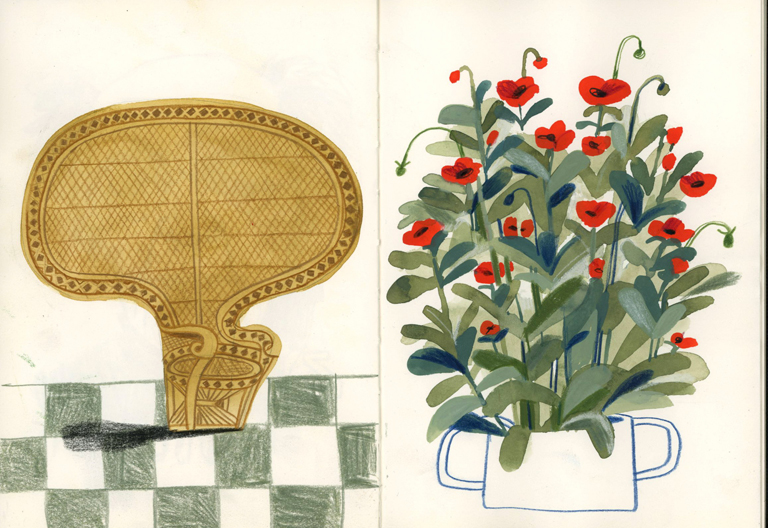A year after writing an article about 'small things', I was asked to write another article for Publisher's Weekly. The article was given the title 'Becoming Small'. Or maybe I gave it that title, I don't remember.
In any case it's something I think about often, as I feel that part of growing older is not, as we think, the distancing ourselves from our childhood (only in terms of time), but in fact the very opposite. The older we grow, the closer we get to what we were as children. At least that is my hope.
Here is the article on PW. I reproduce it here for my records, as I do not often write articles.
The piece came out in time for the publication of my book 'If You Run out of Words', published by Abrams Books in April 2024.
Me and my sister Emanuela, circa 1987, somewhere in Italy.
Becoming Small
It was a day like the day before it, and like the day after it. We had been in lockdown for a few weeks and it felt like this was life now, that it would go on like this forever. I had the feeling we were on top of an ark, and outside it, the virus, the forbidden streets and parks. Other people, far away in their own ships, waiting for a white dove to bring news of land. In that strange time, I observed my 6 year old daughter as she entertained herself with the most fascinating imaginative play. I was worried about her loneliness, but she seemed ok, in the cozy ark, with us. She dressed up, celebrated birthday parties of stuffed toys with great fanfare, created weird sculptures out of mismatched toys, learned to read, ‘played’ with her friends on skype, watched a lot of movies, cooked, made messes, wanted books to be read constantly. We shielded her from the news and told her what was happening using our own language. We tried to protect her from our own anxieties. We did what we could, like everyone in the world, to make it ok.
some images of my daughter's activities in lockdown, Rome 2020
On that day like every other day, my husband, my daughter Nina and I were getting some air on the communal rooftop of our apartment in Rome. I had been on a phone call with my agent Kirsten Hall for at least an hour, chatting about work and life and the absurdity of it all. Nina was starting to get annoyed. She pulled at my shirt, asking me to get off the phone. And then she looked at me with big worried eyes and said: “Mum, what if you talk so much that you run out of words, and then there won’t be any left for me?”
And I laughed and I said, of course I won’t. And I told Kirsten what Nina had said, and she laughed, and then said quite seriously, you NEED to write a book about that.
I immediately felt a sense of anxiety myself. Because I knew that she was right. There was a seed for a great story there, but I did not believe for one second that I was capable of cultivating that seed. I had illustrated many books, but had only written one at that stage, and it was more a collection of people cooking, not quite a story. In fact, I believed quite firmly that I could not write stories, that I was destined to be just an illustrator, and that good writing was rare and done by only the best writers, the qualified ones.
In the following months I thought a lot about that question, what if you run out of words? The unintended brilliance of it. I thought a lot about the way children present us with the funniest ideas that are to them entirely normal and serious. How, in those questions, they sometimes hide their fears and worries about not being loved, not being seen, about being small in a big world. Who will protect them, how can they be sure?
It’s no use to say to a child, don’t worry, you’re being silly, there’s no such thing. We must enter the fear with them, follow that ‘what if’ wherever it wants to go. We must get down on their level, crouching in a makeshift den or hopping over a floor that is made of lava. Let’s see then, together, where this ‘what if’ goes. And then, by seeing that we are not afraid to enter the maze of imagination, they become less so.
My strict ideas about good story writing held me hostage for the following two years, until finally, I gave myself permission to try. I asked myself: What if? I went back to Nina’s question and followed it, like a white rabbit, jumping to a possible answer. If I run out of words, I will go and get an infinity bottle in an underground elf factory. From there, onto a new question and a new answer, until the book somehow took shape. I realized that I had to make myself small (not become a bigger or better author) to go through that elusive door that led to creation. The key to writing was to become one with the child.
Coincidentally, the type of picture books I consider great are the ones that do what is often really hard for us to do as parents and caretakers: they get down to the child’s level, enter their fears and hopes and worries and even absurd ideas, and engage with them with the greatest seriousness (which can be very funny), without condescension, or preaching, or pats on the back. They are not afraid.
Cover for my book, see it here.













































